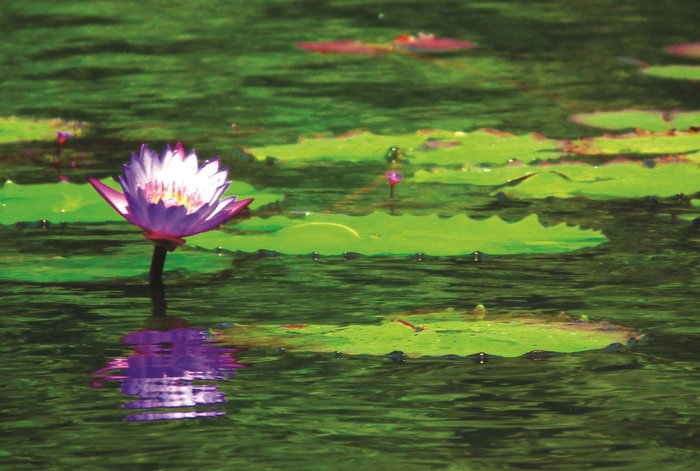Gardening: Horses for water courses

PHUKET: Each and every landscaper worth his salt should incorporate a water feature – if only a modest fish pond – in his garden designs. And even apartment dwellers, with only a concrete balcony to link them to the open air, can think of focal points such as waterproof ceramic pots on plinths, decorated with water lilies or lotuses.
Such simplicities are low maintenance. Apart from the occasional top-up, nymphaeaceae will happily survive the kind of extended dry spell that we recently experienced. And if you introduce small fish, such as guppies and swordtails, you will not only add interest to your water feature, but will ensure that your watery havens do not become breeding grounds for mosquitoes.
If lotuses and lilies are the aristocrats of aquatic plants, then duckweed (lemna) is the poorest of poor relations. Like all plants that float independently on a watery surface, it is simplicity itself to grow.
The plant is composed of tiny ‘leaves’, no more than a few millimeters across, from which dangles a single submerged root. It usually arrives unannounced and within six to eight weeks, if unchecked, will form a dense, brilliant green mat.
Most people dislike it, but unsurprisingly, ducks and some fish, especially carp, as well as frog tadpoles find it succulent. Personally, I allow it a small corner in my fish pond; a place where fry can shelter from their bigger brethren. The plant is easy to control, but also difficult to eradicate entirely.
Another floating plant that is also classed ‘an invasive weed’ in some parts of the globe is the water lettuce, or pistia stratiotes. Like duckweed, it grows very quickly, using its submarine roots to extract nutrients from its surroundings. Also, like duckweed, it forms a green carpet on top of the water.
But there the similarities end. The water lettuce produces rosettes of leaves, often attractively pleated, up to six inches in diameter, that spread out when there is sufficient room, but which grow upright when packed together.
Emerald green in hue, these neat rosettes look better in a confined space – a water jar or ceramic bowl. Pistia propagates itself by offshoots from the mother plant and does best in full sun.
More unusual is the water chestnut (trapa bicornis), though many people are familiar with the nutty fruits that come from this plant’s dark-brown, submerged root system. For this reason, it is cultivated commercially, especially in China.
The actual green plant is less in evidence, though it is sometimes seen decorating ceramic pots outside Thai restaurants or spas in Phuket. What makes it distinctive is the leaves: they are flat and diamond-shaped and form an ornamental and symmetrical pattern on the surface of the water. They can be grown from fresh fruits submerged in water, but unlike the water lettuce, germination is slow – but worth the wait.
There are no comparable issues with the water hyacinth (eichornia crassipes): it grows at such a rate that it can quickly clog waterways – as it has done in Phuket Town. The plant has also taken over a lake in Rawai, with the result that the lake has become invisible.
Is it one to avoid? On one hand, it needs watching and is not suitable for small containers. On the other hand, it produces thick, fleshy green leaves and prominent hollow stalks with dramatic mauve flowers that superficially resemble those of the land-lubber hyacinth. Like the rest of these floaters – the water hyacinth has submerged, free-floating roots – it likes full sun and spreads by means of offshoots.
Free-floaters that never break surface include several plants that quietly carry on with their existence below the surface – generally ideal for aquariums and ponds. One of these is ceratophyllum, a delicate plant with fine, dill-like foliage that encircles its narrow stems.
Another is elodea, or Canadian pondweed. Though these look decorative in glass fish tanks, they provide no visual stimulus in ponds. But undoubtedly they have their uses: they both help oxygenate stagnant water, as well as provide cover for small fry and the eggs that will one day spawn a new generation of fish.
If you have a question or a garden you would like featured, email Patrick at: drpaccampbell@gmail.com. Further information about this gardening series and other work
can be found by visiting: patrickaccampbell.wordpress.com
— Patrick Campbell
Latest Thailand News
Follow The Thaiger on Google News:


























